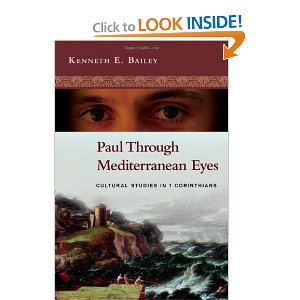What follows in the next ten days, is my extended review and critique of Ken Bailey’s latest book, which won a Christianity Today book award this past year. I have appreciated many of Ken’s interesting insights and perspectives over the years, and nothing I say in this review should be taken to mean that I have changed my mind about that. It is just that this book is not up to the rather high standards he has previously set and has some real issues that should be pointed out. Along the way, I will also point out some of the valuable insights one can gain from reading this book. BW3
——-
Perhaps you remember the famous movie theme the ‘Windmills of your Mind’ which begins as follows:
“Round
Like a circle in a spiral
Like a wheel within a wheel
Never ending or beginning
On an ever spinning reel….
Like the circles that you find
In the windmills of your mind !”
In some very obvious ways, Kenneth Bailey’s recent book, Paul through Mediterranean Eyes, which won the Christianity Today Biblical Studies Book Award earlier this year, will remind you of those lines from that popular song. Why? Because Bailey finds ring structure after ring structure after ring structure (or chiasm) in his analysis of 1 Corinthians. Somewhere along the way, one has to ask— what is wrong with this picture? We will address this issue more directly in a moment but first a review of what this book is and isn’t.
From the outset, Bailey disclaims that he is trying to write a detailed commentary on 1 Corinthians, although this book is over 500 pages long and is full of detailed exposition of the text. He also says up front that he is not trying to interact with the scholarly discussion in any sort of up to date or timely fashion in this work. Indeed, some will be disconcerted that there is precious little interaction with any scholarship on 1 Corinthians from over the last twenty or so years (he mostly quotes commentaries and sources from the 1970s). Bailey is an independent thinker, largely pursuing an independent line, sometimes to his cost, sometimes in helpful ways.
Early on (p. 19) Bailey outlines for us what he intends to bring to the table in this book and it is some of the same sorts of things that made his Jesus through Middle Eastern Eyes (IVP, 2008) interesting and in some ways unique. Firstly, he says he wants to deal with Paul’s ‘Hebrew rhetoric’ in 1 Corinthians largely indebted, in his view, to the OT prophets (chiefly Isaiah and Amos). Secondly, he wants to bring to life Paul’s metaphors and parables with the aid of a body of literature that he, almost alone, knows well—Middle Eastern commentaries on the letters of Paul in Arabic, Syriac, Coptic. And finally, he wants to mine and sample those and other commentaries themselves for the insights into Paul’s diction and ideas.
Some readers no doubt will find it odd that this volume has the phrase in its title ‘through Mediterranean Eyes’ (contrast his Jesus volume) when Bailey continues to call the region the Middle East throughout his discussion. The problem of course is anachronism at several levels. There was no ‘Middle East’ in Paul’s day, only the already Hellenized eastern portions of the Roman Empire which Paul was familiar with, and furthermore later translations and commentaries on Paul’s work which reflect Arab culture or Coptic or even Syrian culture bring with them to the table the cultural differences they are immersed in compared to the Jewish and Greco-Roman cultures of Paul’s world.
While it is certainly true that some aspects of ancient and modern Arabic and Middle Eastern cultures are much closer to ancient Mediterranean culture than modern Western culture is, this is a relative difference. Modern or even ancient ‘Middle Eastern’ culture is not the same thing as any ancient Biblical culture, and the differences definitely matter. They matter because the dominant influence throughout the Roman Empire was of a Greco-Roman nature and that is something very different from Middle Eastern culture, ancient or modern.
Bailey is not afraid to take a minority position on an issue and run with it. Yes, he says in the Introduction, 1 Corinthians is written to the church in Corinth, but it also should be seen as something of an encyclical to the whole church as well. The basis for this conclusion is a rather dubious reading of the Greek of 1 Cor. 1.2. A literal rendering of the verse, clause by clause is— “to the church of God, the one being in Corinth, sanctified in Christ Jesus, called (or even called to be) holy ones, with all those calling on the name of our Lord Jesus Christ, in every place, theirs and ours.” The natural way to take this succession of clauses is that Paul is saying that ‘our churches’ (in this case the Pauline churches) like ‘their’ churches in every place call on the name of the Lord Jesus and are called and called to be holy ones precisely because they are being sanctified by the same Lord. In other words, Paul is quite explicit that what the Corinthians share with everyone else is not this letter, but the saving and sanctifying work of God in their midst which prompts the calling on the name of the Lord Jesus. This letter is written quite explicitly just to one church—‘the one being in Corinth’, otherwise this verse would not distinguish ‘theirs’ from ‘ours’ indicating a subgroup of house churches in Corinthian within the large group of churches in every place.













